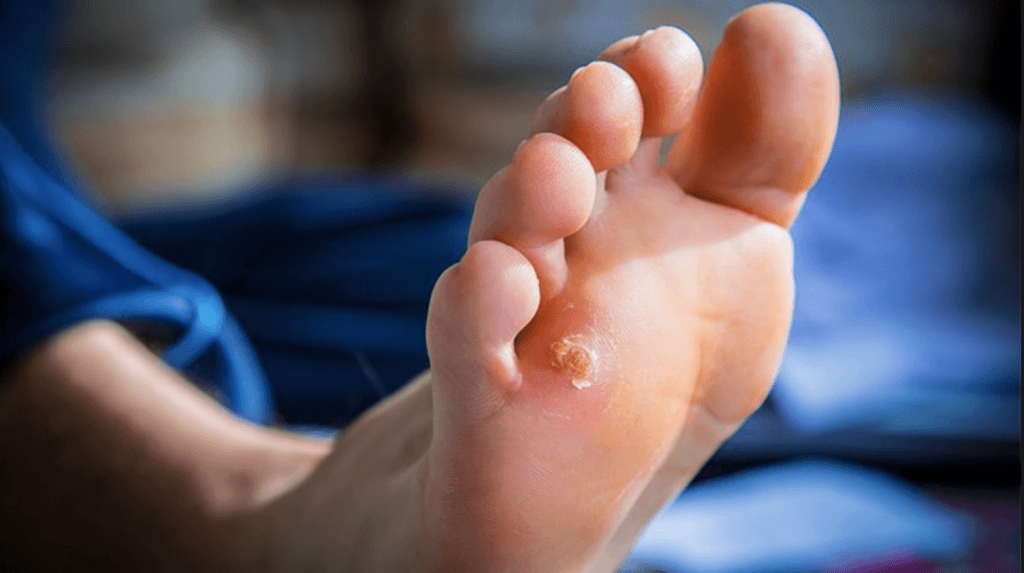Plantar Warts
Plantar warts are small, rough growths on the feet. They usually show up on the balls and heels of the feet, the areas that bear the most pressure. This pressure may also cause a wart to grow inward beneath a hard, thick layer of skin (callus).
Plantar warts are caused by HPV. This virus enters through tiny cuts or breaks on the bottom of the feet.
Most plantar warts aren’t a serious health concern. To get rid of plantar warts our team of highly experienced Podiatrists are able to advise you on the best course of treatment.
Symptoms of Plantar Warts
- A small, rough growth on the bottom of your foot, usually at the base of the toes or on the ball or heel
- On brown and Black skin, the growth may be lighter than unaffected skin
- Hard, thickened skin (callus) over a spot on the skin, where a wart has grown inward
- Black pinpoints, which are small clotted blood vessels commonly called wart seeds
- A cluster of growths on the sole of the foot (mosaic warts)
- A growth that interrupts the normal lines and ridges in the skin of your foot
- Pain or tenderness when walking or standing

Wart Treatments Available
Wart curettage is a simple sterile surgical procedure that is carried out on long standing chronic warts which have been resistant to other conservative treatment methods.
The procedure involves utilising local anaesthetic and excising or removing the wart tissue from the foot using sterile instruments.
This procedure is similar to nail surgery in the way that we utilise local anaesthetic and can be undertaken in the surgery rooms.
If I have only recently developed a wart on my foot would I need curettage?
That depends on the complexity of the wart. In the first instance we always aim to utilise conservative methods e.g. acid therapy and over the counter medications as this is often all that is required to manage and eradicate these warts. However, on stubborn long-term warts curettage often is more effective in the long term.
Will I need to be in hospital?
No, this is a simple day surgery that can be carried out in our rooms.
Am I able to drive home after the surgery?
We recommend organising to have a lift home as your foot will have had anaesthetic injected therefore your ability to detect the car operational pedals could be impaired which is a safety issue. The day after surgery the anaesthetic will have worn off and you can return to driving again.
Falknor’s needling uses an empty sterile needle to puncture and break down the plantar wart (verruca). This causes a little bleeding, which activates your body’s immune system response. Once the immune system becomes aware of the virus, it starts the process of self-healing, destroying the diseased cells.
The procedure involves three stages:
1. Firstly, the area is prepped using an aseptic technique. Then a small amount of local anaesthetic is administered to the area surrounding the wart. The surrounding area and the wart then become numb before the procedure.
2. Once the area to be treated is completely numb, we proceed to repeatedly puncture the wart with a hypodermic needle. This pushes the virus into the deeper layers of skin so that your body’s immune system can come into contact with it and start the self-healing process.
3. Finally, we apply a dry dressing to cover the small wound. This must be kept dry for at least 48 hours and you should avoid walking or driving while your foot is still under the effect of anaesthesia.
The anaesthetic will start to wear off in 2 to 3 hours, but do not be concerned if it takes a little longer as the effects vary from person to person.
After 48 hours showering is permitted and life can continue as normal, although you may experience minor soreness for 2 to 3 days post-treatment. We recommend keeping a simple dressing on the area to reduce risk of infection, this is to be changed daily.
Usually 1-2 treatments are needed to completely eradicate plantar wart. Most patients don’t see a full change in the skin until 16 weeks after the treatment, hence you may not see complete results for 4 months.
Acid treatments involve the application of varying strengths of acid directly to the wart area. The duration of treatment time is dependant on severity, size and location of the wart. Also the concentration or potency of the acid that is selected for treatment is also dependent on the severity of the wart.
Treatment Protocol
- The Podiatrist will debride or remove the callus from the overlying wart and then apply the topical acid medication to the area and cover it with a dressing.
- The dressing remains in place for 48hrs then removed and the area cleansed.
- For the next 1-2 weeks topical over the counter treatments are purchased from the pharmacy and applied at home
- Review appointment with Podiatrist in 1-2 weeks
- It is normal for the area to become inflamed, appear white and boggy with some minor discomfort. This typically subsides within a few days.
- Treatment intervals with a Podiatrist are usually every 1-2 weeks until the wart has been eradicated
Need more information or would like to discuss treatment options book in with one of our podiatrists and they will be happy to answer any questions you may have. Call our office or book online via our website www.enablepodiatry.com.au


